Producing an exquisite cup of coffee is not a straightforward affair. On paper, however, it looks quite simple. Grow the plant, harvest the fruit, process the beans, grind into a coarseness of your choice, and use this to create an espresso, latte, macchiato or whatever style of coffee you think is superior. Of course the true story is slightly more complex than that.
The growing process alone could be documented in a series of dense tomes, and every step thereafter is a combination of differing factors which alters the final flavor of the coffee in innumerable different ways. The way in which the beans are roasted are, of course, critical to how they taste. But an often overlooked step, which is equally, if not more crucial, to the creation of a delicious brew, is the way in which the beans are ground.
Grinding itself is a science. There are various schools of thought which approach the process of grinding with the same zeal as a scholar approaching a humanities discipline, or a sommelier inspecting the soil of his vineyard. It’s a skill, and one that requires some foreknowledge, but one that can be learned.
And like many skills that can be mastered – it requires tools.
Different types of Grinders
Grinders can roughly be divided into two categories – burr grinders and blade grinders. The grinder which coffee aficionados, both amateur and professional, choose to use are governed by a number of critical factors and preferences.
Blade grinders, as the name suggests, utilize blades to aid in the grinding of beans. They’re generally the cheapest type of grinder on the market, as the blade method used to slice the beans into ever smaller pieces can often result in grain inconsistencies. The heat generated by these grinders can also taint the bean as it’s being ground, and affect its final taste.
Burr grinders are different from blade grinders in that they crush the beans against a non-moving surface using a grinding wheel instead of blades. This burr can be adjusted to multiple settings, giving you control over the exact coarseness or fineness of the final grounds. This level of customization allows for greater accuracy and consistency, and makes these type of grinders a firm favorite among baristas and other coffee professionals.
These styles of grinders are also available in both manual and electric varieties. The choice of one over the other comes down the goals you want to achieve when it comes to creating coffee. Do you want something fast and convenient but expensive, or something smaller, cheaper, more personal and portable?
The devil is in the details, but for the sake of this guide we’re going to be focusing only on manual coffee grinders.
Choosing the Best Manual Coffee Grinder: What We Looked At (Our Ranking Factors)
Specifically, we’re focusing on what to look for when buying a manual coffee grinder and what makes it great. We’re also going to provide a list of our firm favorites currently on the market. To do this we’re going to focus on a number of different factors which all grinders share, including:
- Bean capacity
- Grind settings
- Price
- Design
- Durability
The Top 6 Manual Coffee Grinders Ranked
Grinder & Price |  Pros & Cons |
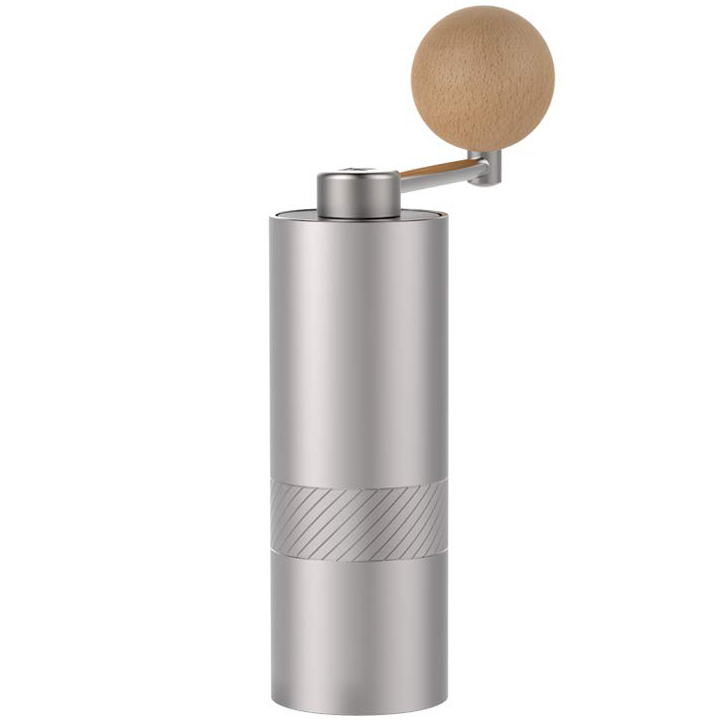 1Zpresso Mini Q Check Latest Price | + Extremely portable. + Produces consistent grinds of any fineness or coarseness. – Small bean capacity. |
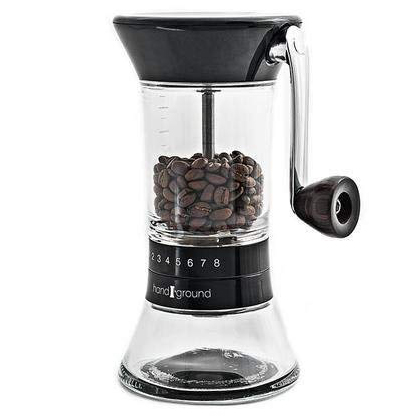 Handground Precision Check Latest Price | + Made from quality materials; very durable and aesthetically pleasing. + Can set grind size easily without disassembling. – Larger grind settings can possibly yield grind inconsistencies. |
 Lido 3 Check Latest Price | + Large bean capacity. + Great selection of different grinds. + Features Swiss-made conical steel burrs – Plastic Body (hopper and catch jar). – Fairly expensive for the body material it’s constructed from. |
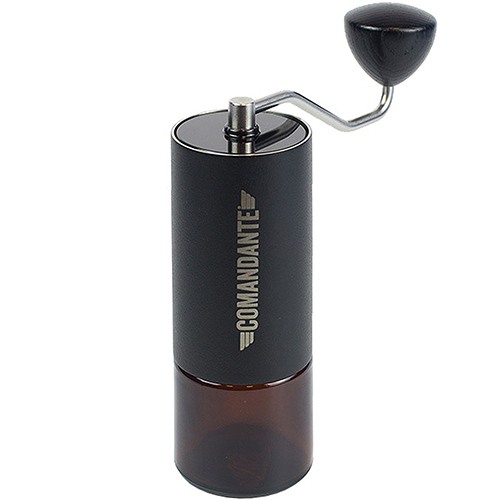 Comandante C40 Check Latest Price | + Extremely robust. + Advanced stainless steel burrs result in a much more consistent grind. + Aesthetically pleasing. – Quite a large price tag, especially for home baristas. – Glass grounds catcher may be prone to breaking if dropped. |
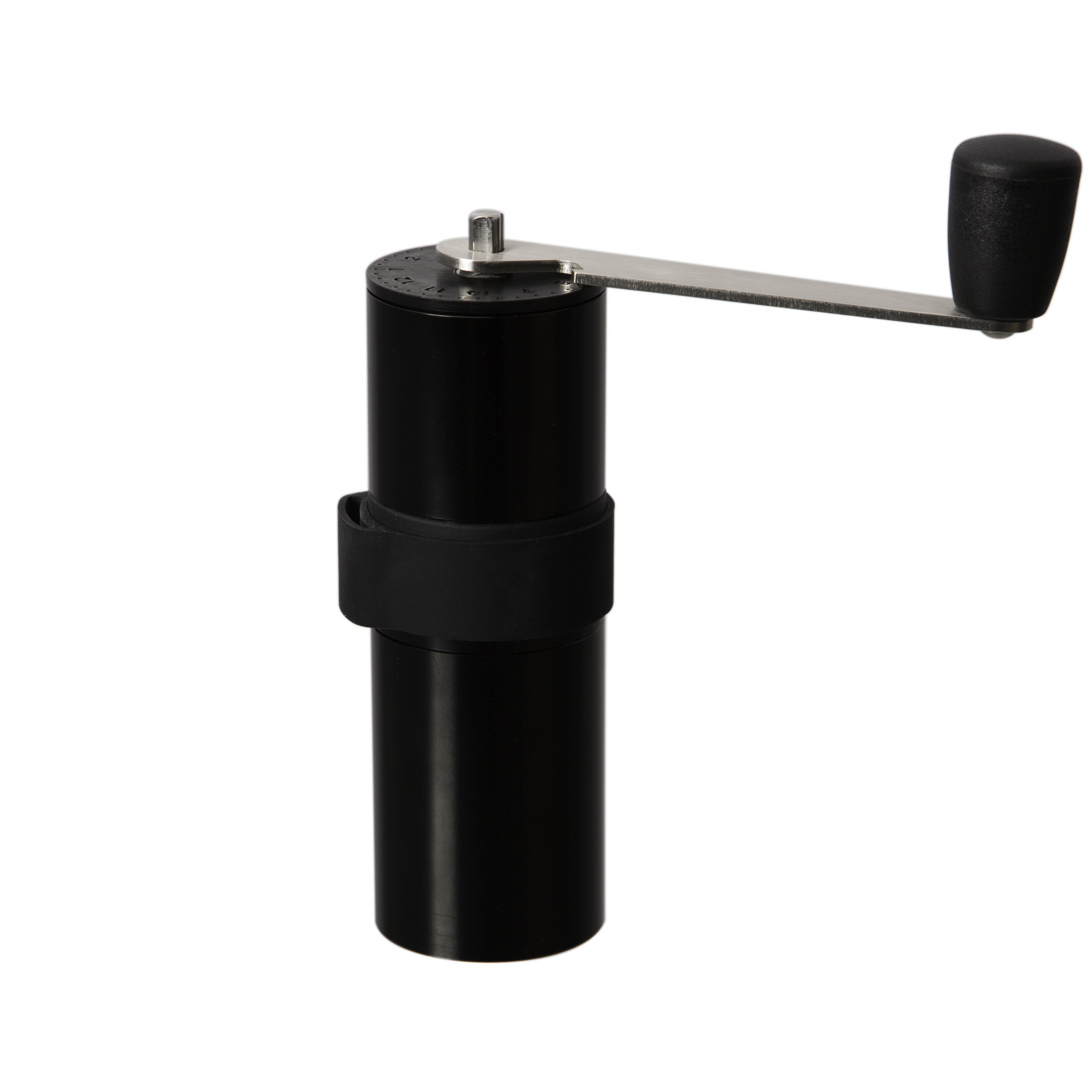 Knock Aergrind Check Latest Price | + Lightweight and compact. + Durable materials and construction. – Dial lid sips off of the shaft fairly easily. – Finer grinds tend to stick to the bottom edge of the container; can be a bit tricky to clean. |
 Helor 101 Check Latest Price | + Performs as well as grinders far more expensive. + Excellent contemporary burrs. + Exquisite finish and aesthetic. + Lightweight, yet the grind quality is flawless. – Very expensive for amateur coffee aficionados. |
Manual Coffee Grinders: Product Breakdown & Reviews
1Zpresso Mini Q – The Best Manual Grinder for Travel
Born from a Taiwanese company that produces only hand grinders (and one manual espresso maker), the 1Zpresso Mini Q is a product born of a company with a singular focus. That’s great news for coffee drinkers, and even better news for coffee drinkers who travel, because as the name suggests, the 1Zpresso is the ideal travel grinder. Weighing in at 445g, the 1Zpresso isn’t exactly weightless, but it’s not heavy either.
It’s solid construction and brushed aluminum alloy finish make it heavier than you might expect, but with a diameter of just 4.8cm and the ability to hold upwards of 20g of beans within its hopper, it’s still the perfect size for travel.
Its burrs, while excellent, don’t always result in the most consistent grind. That being said, it’s still an excellent mid-level grinder that could even be used comfortably at home, especially with a reasonable price tag of $94.05.
Handground Precision Coffee Grinder – The Best All-Rounder
With an easy price tag of $79.95, up to 15 grind settings that can effortlessly produce grounds for pour over, French press, espressos and even Aeropress, a wonderfully practical build quality and the ability to produce a consistent grind, the Handground Precision Coffee Grinder is the best all-rounder manual coffee grinder on the market.
The Handground is also very stable, making grinding beans a simple and comfortable process. It’s functionality is that of a grinder twice its price, and its build quality means you don’t have to break a sweat in order to get the necessary coarseness for a cup of pour over.
If there was some criticism to levy, it might lie in the grinder’s size. With a hopper big enough to hold 100g of beans and towering at 8.7 inches, the Handground is definitely not suited to travel, and might take up considerable space on your countertop.
If this is an inconvenience to you it can be overlooked in favor of the grinder’s numerous other features including 38mm ceramic burrs, the 20 preset coarseness levels, as well as the external coarseness adjustment ring which means you don’t need to breakdown the machine in order to change its settings.
The placement of the handle on the side of the grinder rather than the top makes for a smoother, more natural movement when grinder.
Overall, for the price and the quality, it’s hard to find a better all round manual coffee grinder.
Lido 3 – The Sturdiest Manual Grinder
At $195, the Lido 3 packs a price tag which promises a lot – and it delivers, mostly. Featuring a beefy 48mm set of Swiss-made steel burrs, the Lido 3 makes short work of any large quantities of beans, delivering a consistent grind and requiring very little manual force to do so. It’s a full-range grinder which can produce everything from Turkish to espresso to French press grinds very easily.
Setting the grind size is a bit of a pain, however, and requires some trial and error in order to select the correct grind size. Once you have it dialed in, however, the Lido 3 is a pleasure to use.
While it’s marketed as a travel grinder to use at home, the Lido 3 weighs a hefty 2lbs 5oz, making it portable but only just. That being said, as a staple grinder in the kitchen, it’s a wonderful addition to a barista’s tool set. The only off-putting thing might be its construction which, for carrying around a price tag almost as heavy as its body, contains way too much plastic for a premium-level grinder.
Comandante C40 MK3 – The Best Specialist Manual Coffee Grinder
As a successor to the MK2, the Comandante C40 MK3 is a premium, high-end grinder that delivers everything it sets out to do. It’s a beautifully constructed manual coffee grinder with an exquisite wooden finish.
The grinding mechanism is the C40’s true strength. The Nitro Blade stainless steel burr set is a serious engineering feat, and exemplary of the finest German craftsmanship. This material means that the burrs and the entire grinder are tough, resistant and maintain a high degree of edge retention. Setting the desired grind size is also an effortless affair, making the entire process of grinding from start to finish a pleasant affair.
If you’ve got the money, then this is where you should be spending it.
Knock Aergrind – The Best Companion For an Aeropress
If you’re on the road constantly and in need of a good cup of coffee then the Knock Aergrind might be exactly what you’re looking for. After the success of his previous grinder, the Feldgrind, Peter Kilpatrick decided he could do one better with the Aergrind.
Featuring 38mm hardened steel black burrs and a stepless grind adjustment, the Aergrind produces a consistent grind while also remaining stable. It’s construction is sturdy, lightweight and small enough to fit into an Aeropress.
At $159.99 the Aergrind on the higher end of the spectrum for manual travel coffee grinders, but its quality and performance make it worth the price if you’re looking for something that will provide consistently good grinds.
Helor 101 – The Best Double Burr Manual Grinder
The Helor 101 is a beautifully svelte grinder that looks like it comes from the future. The entire body is crafted from 6000 Series aluminium block, and this makes for a sturdy and stable tool when grinding your beans.
The Helor 101 features ceramic bearings in order to create a smooth grinding experience, and one that will never require any lubrication and that won’t result in any weathering of the parts. The key to its pristine functionality is the fact that it uses two sets of burrs – one conventional and one contemporary. The contemporary burrs are used to for grinding brewed coffee, while the conventional ones are used to make espresso.
The exact grind you want can be achieved by adjusting the grind settings at the bottom of the grinder. It’s an easy process which makes for an incredibly consistent grind, and the ceramic bearings ensure that the grounds are never heated and therefore that the flavor remains unaltered.
Manual Coffee Grinders: The Complete Buyer’s Guide

It helps to have a basic framework to work with, know what specifications to look for, the best brands on the market as well as the definition of relevant coffee grinder jargon. We’ve narrowed it down for you below.
Specifications
- Particle size and consistency – perhaps the most important factor when buying a manual coffee grinder, this refers to how fine or coarse the final grounds will be, and how consistently the grinder performs.
- Cost – Grinders come in all shapes and sizes, not to mention different costs. A good grinder isn’t cheap, and a cheap grinder most likely isn’t good. If you want something that does that job consistently, expect to pay anywhere from $70 – $300.
- Grind settings – Most coffee drinkers drink an array of different coffees, and so require a grinder with multiple grind settings. These generally come in the form of stepped and stepless, which refer to either having a number of predetermined grind settings, or a wide range without any presets.
- Bean capacity – The number of beans which a grinder contains. This generally depends on what coffee you intend to make and how many people you intend you brew for. If you’re someone who travels often, a 15g hopper will be perfect, but if you’re making coffee for friends at home, you’ll need something closer to 100g.
- Size – Again, this depends on your needs. Manual coffee grinders come in various different sizes. You want to determine if you have enough countertop space in your kitchen for the grinder of your dreams.
- Speed – It may sound counterintuitive, but when it comes to manual coffee grinders, slower is better. High speed grinders tend to heat up which in turn affects the taste of the bean and the final product. On top of that, high-speed grinders wear out more quickly than their sturdier, more stately counterparts.
- Ease of use and cleaning – Grinding takes time. The amount of effort you’re willing to put in first thing in the morning in order to produce the perfect cup of coffee is a big consideration when it comes to buying a grinder. Some grinders are simple and require little effort to use, others are more complex, and can be a pain to clean.
- Burr Material – Burrs are generally made from stainless steel or ceramic. Ceramic burrs have the benefit of being more hardy and producing more consistent grinds, but if something happens to one of them, they’re quite a mission to replace. Stainless steel burrs, on the other hand, perform pretty well across the board, and are way easier to replace.
- Durability – Manual coffee grinders are expensive, and so you’re going to want one that has a decent shelf life. Grinders made from higher quality materials are likely to last longer, so you may want to factor this into your pricing. Afterall, why buy two inferior grinders when one superior grinder will outlast both?
Best Brands on the Market
- Handground
- Hario
- JavaPresse
- Norpro
- Fecihor
Red Flags to Consider When Buying A Manual Coffee Grinder
Cheap price tag – As the saying goes, if it sounds too good to be true, it probably is. The same can be said when purchasing manual coffee grinders. While they’re not the most expensive product in the world, if they’re advertised as extremely cheap, then the functionality is likely going to mirror the price. Rather pay a little more for something of exponentially higher quality, rather than trying to score a good only to have to replace your grinder in a few month’s time.
Poor build quality – For a manual coffee grinder to perform optimally, it needs to have a solid, robust construction. Cheap materials and low build quality will result in an uneven and inconsistent grind, and this will ultimately affect the final flavour of the grounds. Always check that your manual coffee grinder has high-quality burrs and construction in order to have it last for years to come.
Constantly jamming – While it’s normal for a manual coffee grinder to jam once in a while and require some cleaning, if your grinder is constantly jamming this is a sign that your burrs aren’t grinding correctly and may need replacing.
Small hopper – Grinding beans takes time, so it helps to have a substantial hopper capacity that allows you to grind up a modest amount of beans in one sitting. A small hopper isn’t always a red flag, especially if you’re using it to travel, but if you’re planning on grinding your own beans at home then opt for something that can grind enough for at least a few cups of coffee.

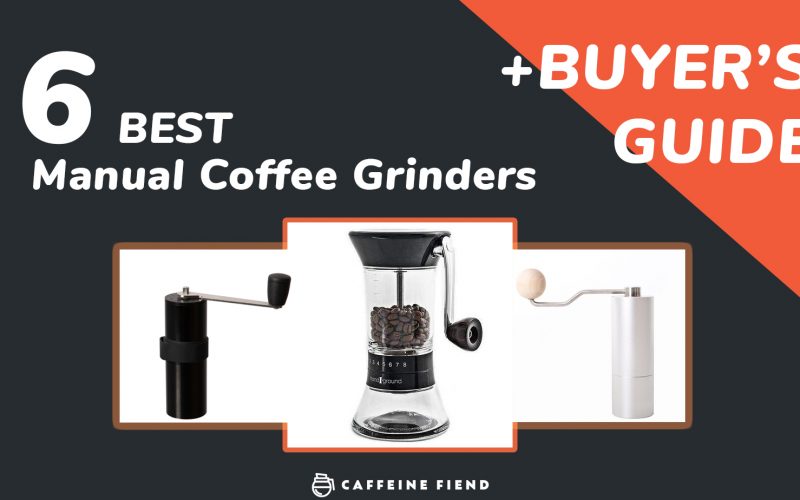
3 comments
Your chart up top says the Lido 3 is “made entirely from plastic”
What?? That is completely false. Only the knob on the handle, the hopper and the catch jar are made of plastic. Everything else is anodized or coated aluminum and steel. I have no affiliation with OE but I own and use a Lido E-T.
Hi there 🙂
What we meant here is that the Lido 3 features a plastic body (hopper and jar) which constitutes a great proportion of its build. The knob seems to me like rubber, while the conical burrs are Swiss-made steel. I understand the wording is definitely not literal – so I’ve made the necessary changes to the chart.
Thanks again for pointing this out!
Hi there!
You seem to omit on your list one very popular, quite robust and neatly portable grinder, that fits snugly into Aeropress.
That is Porlex Mini.
It may look like those cheap Amazon’s grinders from China but there’s quality behind this little gizmo from Japan.
Kind regards,
KruK